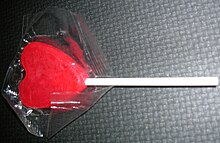| Revision as of 15:34, 10 February 2007 view source67.80.42.200 (talk)No edit summary← Previous edit | Revision as of 15:34, 10 February 2007 view source Maxim (talk | contribs)Bureaucrats, Administrators40,757 edits rvvNext edit → | ||
| Line 4: | Line 4: | ||
| A '''lollipop''', '''lolly''', or '''sucker''' is a type of ] consisting mainly of hardened, flavoured ] with ] mounted on a stick and intended for ] or ]. In many regions of the United States (primarily the South and Midwest), the term "sucker" is used interchangeably with or instead of "lollipop". In these areas, the term "lollipop" is often applied to candy that is disc-shaped, while "sucker" is applied to candy that is spherical. Lollipops come in a variety of flavors from ], ], ], and ] to ] and ]. In ], especially the ], ] and ], ]-flavoured lollipops are also available, but these are largely unknown in other parts of the world. With numerous companies producing lollipops, the candy now comes in dozens of flavors. | A '''lollipop''', '''lolly''', or '''sucker''' is a type of ] consisting mainly of hardened, flavoured ] with ] mounted on a stick and intended for ] or ]. In many regions of the United States (primarily the South and Midwest), the term "sucker" is used interchangeably with or instead of "lollipop". In these areas, the term "lollipop" is often applied to candy that is disc-shaped, while "sucker" is applied to candy that is spherical. Lollipops come in a variety of flavors from ], ], ], and ] to ] and ]. In ], especially the ], ] and ], ]-flavoured lollipops are also available, but these are largely unknown in other parts of the world. With numerous companies producing lollipops, the candy now comes in dozens of flavors. | ||
| They were first commercially manufactured on a large scale in the ]s |
They were first commercially manufactured on a large scale in the ]s. Some lollipops contain fillings, such as ] (]) or ]s (]s). Notable ]s include ] and ]. | ||
| The term "lollipop" was first recorded in ] in ] (Shorter Oxford English Dictionary, 1973), denoting a ] consisting chiefly of sugar or ]. The first element is perhaps related to "loll", meaning "to dangle" (as in a tongue) — "lolly" was also a northern dialect word for the tongue, although this may in fact be derived onomatopoeically from the mouth sounds associated with sucking and licking. | The term "lollipop" was first recorded in ] in ] (Shorter Oxford English Dictionary, 1973), denoting a ] consisting chiefly of sugar or ]. The first element is perhaps related to "loll", meaning "to dangle" (as in a tongue) — "lolly" was also a northern dialect word for the tongue, although this may in fact be derived onomatopoeically from the mouth sounds associated with sucking and licking. | ||
Revision as of 15:34, 10 February 2007
- For other uses of the term "Lollipop", see Lollipop (disambiguation).

A lollipop, lolly, or sucker is a type of confectionery consisting mainly of hardened, flavoured sucrose with corn syrup mounted on a stick and intended for sucking or licking. In many regions of the United States (primarily the South and Midwest), the term "sucker" is used interchangeably with or instead of "lollipop". In these areas, the term "lollipop" is often applied to candy that is disc-shaped, while "sucker" is applied to candy that is spherical. Lollipops come in a variety of flavors from cherry, grape, blueberry, and orange to watermelon and green apple. In Europe, especially the Nordic countries, Germany and the Netherlands, salmiakki-flavoured lollipops are also available, but these are largely unknown in other parts of the world. With numerous companies producing lollipops, the candy now comes in dozens of flavors.
They were first commercially manufactured on a large scale in the 1920s. Some lollipops contain fillings, such as bubble gum (Blow Pops) or Tootsie Rolls (Tootsie Pops). Notable brand names include Chupa Chups and DumDums.
The term "lollipop" was first recorded in England in 1769 (Shorter Oxford English Dictionary, 1973), denoting a sweetmeat consisting chiefly of sugar or treacle. The first element is perhaps related to "loll", meaning "to dangle" (as in a tongue) — "lolly" was also a northern dialect word for the tongue, although this may in fact be derived onomatopoeically from the mouth sounds associated with sucking and licking.
The origin of the lollipop has yet to be determined. Both Racine, Wisconsin and San Francisco, California, claim that they made the first automatic lollipop maker.
In popular culture
You must add a |reason= parameter to this Cleanup template – replace it with {{Cleanup|September 2006|reason=<Fill reason here>}}, or remove the Cleanup template.
- Lollipops are featured as a source of super powers in Herbie comics, in which lollipops are used for bopping, magic, and time travel.
- In Formula One, the device used to give signals to a driver while he is pitted is called a "lollipop".
- In the United Kingdom and Australia, the term 'lollipop' is also used to describe the disc on a pole carried by school crossing staff, hence the terms 'lollipop lady' or 'lollipop man'.
- In Australia, 'lollies' is a generic term used to describe sweets (confectionery), as opposed to the American description of them as 'candy'. 'Sweets' is an English term.
- Sometimes lollipops are used in censorship of animated television programs by replacing cigarettes or, to a lesser extent, cigars.
External links
- National Confectioners Association History of lollipops